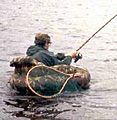Dip net facts for kids
Dip netting is a fun way to catch fish using a net while standing or wading in the water. In Alaska, many people enjoy dip netting. They often camp by the river and catch enough fish to last them all year!
Contents
How Fish Nets Started
Fishing nets are some of the oldest tools people have used to catch fish. They can be made from many different materials like nylon, cotton, grass, flax, and even tree fibers. The oldest known fishing net was found in a place called Antrea and dates back to about 8500 BC!
Long ago, Native Americans living near the Columbia River made their nets from strong plants like grass, cedar, and spruce root fibers. Dip netting, as we know it today, started in the Copper River area in 1989. However, it wasn't until the spring of 1996 that the Alaskan government officially allowed residents to do it.
Fish You Can Catch
When you go dip netting, you can catch many different kinds of fish. Some of the most common ones are Hooligan, king salmon, red salmon, pink salmon, silver salmon, and flounder.
Hooligan
Hooligan fish are also known as candlefish. They are very important to animals like eagles, gulls, and bears. You can find these fish in the Pacific Northwest of Alaska. Dip netting is a great way to catch them. If you are an official Alaskan resident and have a fishing license, there's no limit to how many hooligan you can catch! Thousands of hooligan swim into rivers to lay their eggs every year.
Salmon
Salmon are amazing fish! They are usually born in fresh water, like rivers. After they hatch, they slowly swim out to the salty ocean. They live in the ocean for about four to six years. Then, they swim back to a river to lay their eggs. These eggs hatch after about a month. The baby fish are called "fry" because they look like tiny, long fries swimming in the water!
King Salmon
King salmon are known as the "kings" of all fish because they are very big and strong. They can grow to be 30 to 40 inches long! You can find them in Southeast Alaska, around Prince William Sound, and in the Bristol Bay area. Many people like to catch king salmon because their meat is rich in healthy fats called omega-3 fatty acids. They are also exciting to catch because they fight hard!
Sockeye Salmon
Sockeye salmon, also called red salmon, are very popular because their meat is a bright orange color. They live in the Northern Pacific Ocean and in rivers. These fish can grow up to 33 inches long and weigh between 4 and 15 pounds. They usually live for 3 to 7 years and are a favorite food for marine mammals and bears.
Pink Salmon
Pink salmon are sometimes called "humpy fish." You can find them in Southeast Alaska and Prince William Sound. Male pink salmon are easy to spot because they have a large hump on their back. Females look much slimmer. Many seabirds, bears, wolves, otters, and bald eagles eat pink salmon in this area. Pink salmon that live in saltwater are usually smaller and have softer meat than those in freshwater. Freshwater pink salmon are typically 20 to 25 inches long. They often swim with other fish like king and silver salmon. Pink salmon are often easier to catch if you use the right fishing method.
Silver Salmon
Silver salmon are also known as coho salmon. They have deep bodies and black spots. You can find them in the Northern Atlantic and Pacific oceans. They can grow up to 30 inches long and usually live for 2 to 4 years.
How to Dip Net
There are two main ways to dip net: stationary and sweeping.
Stationary Dip Netting
There are two stationary techniques:
- Kick netting: This is when you place your net at the bottom of the river, where there are lots of rocks. Then, you kick the water to scare fish into your net. Be careful, though, because your net can get damaged easily this way!
- Body rushing: For this technique, you use your body to help catch fish. When a group of fish swims by, you swing your body from side to side. This can scare the fish and make them swim right into your net!
Sweeping Dip Netting
There are three types of sweeping techniques:
- Sight dipping: This is when you see fish in the water and try to scoop them up with your net.
- Scooping: With this method, you dig your net blindly between rocks or into bushes of weeds. You hope to catch fish that might be hiding there.
- Dredging: This technique involves dragging your net along the bottom of the river. The net picks up mud, weeds, and other things that can trap fish.
Images for kids
-
Dipnet fishing platform on the Columbia River in Cascade Locks, Oregon
See also
 In Spanish: Salabre para niños
In Spanish: Salabre para niños





